How To Reupholster A Dining Chair New Foam
How to Reupholster a Chair
Anyone can make a nasty seat nice in just a couple of hours. Here's how to do a first class DIY chair upholstery job.
![]() Time
Time
A full day
![]() Complexity
Complexity
Beginner
![]() Cost
Cost
$51–100
Introduction
If you have worn-out chair seats, you can easily re-cover them. Make a mistake? No problem. Just pull a few staples and start over. Reupholstering is a great way to bring tired-looking chairs-even tired-looking rooms-back to life. The materials are relatively inexpensive, the tools are simple and it's a project almost anyone can tackle with success.
Tools Required
Materials Required
- 1" x 24" x 24" high-density foam
- 1/2" to 3/4" plywood (if needed)
- 24" x 24" landscape fabric (optional)
- 30" x 30" quilt batting
- 30" x 30" upholstery fabric
- Upholstery staples
Project step-by-step (11)
Step 1
Chairs are not all created—or upholstered—equally
Here we'll show you how to reupholster a chair with a 'drop-in' or 'screw-on' seat-a style shared by many benches and stools. Seat bases can be constructed from a variety of materials: solid wood, plywood, pegboard and others. The seats are normally screwed on but can also be glued on or dropped in. The cushions can be foam, cotton or other natural materials.
Which stapler works best?
All the staplers shown will do the trick. The question is: How hard do you want to work-and squeeze-to 'do the trick'? Your stapler buying decision may also hinge on a few other factors, including how often you'll use it, what else you might use it for-and whether you need a good excuse to buy an air compressor.

Hand Stapler:It will give your hand a workout, and you may have to occasionally use a hammer to drive the staples all the way in, but you can still get good results. Make sure you hold the nose of the stapler firmly against the seat base when you pull the trigger.
Cost: $15 to $30

Electric Stapler:
We used one for our project and it worked flawlessly. You still need to firmly press the nose against the fabric and plywood to get a well-seated staple-but it's way easier on the hand. As a bonus, some models also shoot 3/4-in. and shorter brad nails.
Cost: $25 to $75

Pneumatic Stapler:
If you're going to be stapling for hours on end, invest in a pneumatic stapler. These drive the staples flush with the pull of a finger and allow you to be extremely accurate in the placement of your staples. Some tools also drive brad nails up to 1-1/4 in.
Cost: $40 to $150 (plus air compressor)
Perfect Patio Chairs
Step 2
Round up your materials
When you shop, buy 'upholstery grade' fabric for its strength and stain resistance. Fabric prices vary wildly; you might find something for $5 in the bargain bin or spend 10 times as much. We bought our fabric, foam and batting at a fabric store. For the dust cover, we used landscape fabric from a home center.
10 Easy Wooden Lawn Chairs & Benches to Build
Sign Up For Our Newsletter
Complete DIY projects like a pro! Sign up for our newsletter!
Do It Right, Do It Yourself!
![]()
Step 4
Make a new seat
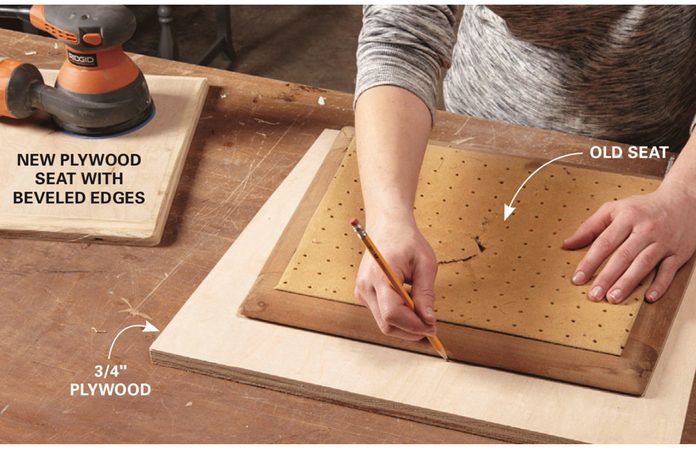
If the old seat is in bad shape, cut a new one from plywood. Trace around the old seat, then cut with a jigsaw or circular saw. Bevel or soften edges with a sander or router to match the old contour. Plus: How to Install a Chair Rail
Step 5
Cut the foam
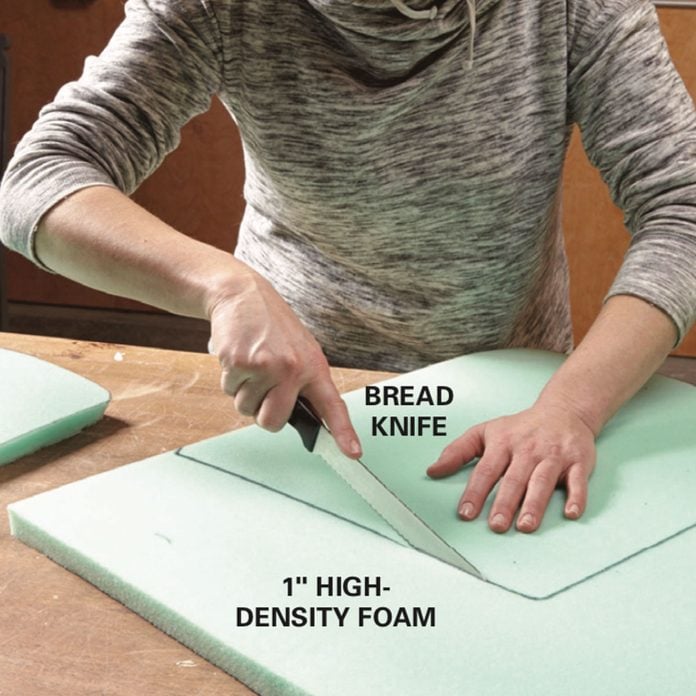
Trace the outline of the seat onto 1-in.-thick foam. Cut the foam with a bread knife. To avoid tearing the foam, pull the knife toward you, using light pressure and short strokes.
Our seats, for example, were made from a pegboard-like material secured to a 1x3 framework, covered with horsehair padding. Someone had already reupholstered the chairs, going directly over the old fabric. Expect the unexpected and adjust your game plan accordingly. If you're re-covering more than one chair, number each chair and seat; that way, the screw holes will line up properly when you reinstall the seats. There are special tools just for yanking upholstery staples or tacks, but you can get by with basic hand tools (Photo 1). Tip: Old, dull side cutters are perfect. They grip staples well but don't cut them off.
Remove the padding and inspect the seat. If the wood base seems solid, reuse it. If it's cracked, use it as a template to make a new one (Photo 2). We used a sander to taper the edges to match the profile of the old one. Plop the seat on top of the foam and outline it with a marker. Use a serrated bread knife (Photo 3) to cut just inside the line.
How to Build a Patio Chair
Step 7
Center the pattern

Determine the best layout for your material; make sure any patterns or stripes align correctly. Hang the edge of the seat over your work surface then drive a staple, from below, in the centers of the front and back.
How to Build an Adirondack Chair
Step 8
Staple the front edge
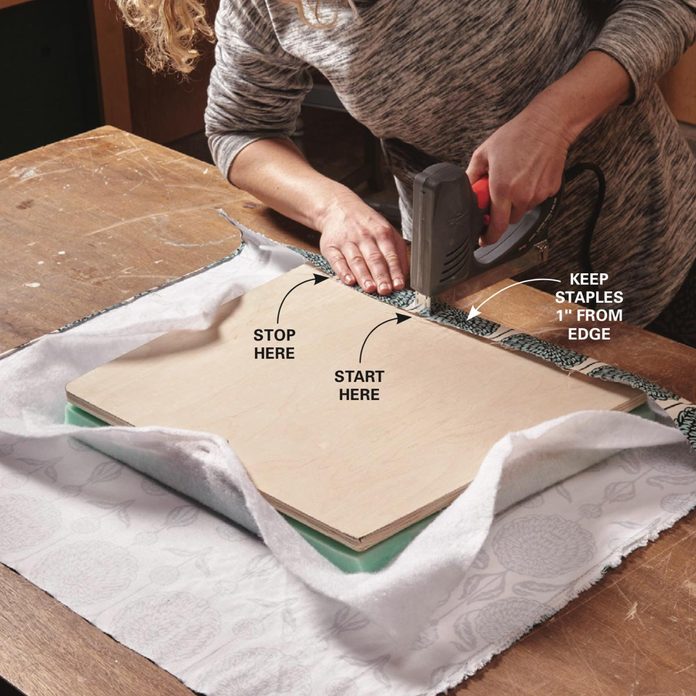
Working from the center outward, install staples along the front as you lightly tension the material with your hand. Stop 2 in. from the corner. Flip the seat over several times to check the pattern as you go. Repeat the process along the back edge and sides. Place a section of batting-4 in. wider in all directions than the size of your chair seat-on a flat work surface, then set your foam and seat on top. Lightly stretch the batting and drive one staple (Photo 4) along each edge.
Flip the seat over, then center your material on top (Photo 5). Cut the material so you'll be able to wrap it up onto the chair bottom at least 4 in. in each direction. With the seat facing up and the front edge overhanging the work surface, drive one staple through the bottom to hold the material in place. Rotate the seat 180 degrees, then tack the back the same way.
Check your pattern alignment one more time, then flip the seat upside down. Starting at the front middle staple and working toward the corners, use the palm of your hand to lightly stretch the material, then drive a staple every 2 in. (Photo 6). Keep the staples within an inch of the edge, and secure the batting and fabric at the same time. Use your entire hand, not just fingertips, to tighten the material. This way you'll avoid little dips and puckers in the pattern.
Repeatedly flip the seat over to check the pattern for straightness; it's easier to keep flipping and checking than to go back and pull staples. Our expert flipped the seat over and checked the pattern a dozen times while stapling each edge. Stop stapling 2 in. from each corner. Secure the back edge in the same way, stretching the material lightly as you work. Then complete the sides, again repeatedly checking the pattern.
15 Adirondack Chairs You Have to See to Believe
Step 9
Corners are the key
Trim the corners

Cut off the excess batting and upholstery so you don't end up with ugly lumps at corners.
DIY Dictionary: Chair Rail
Step 10
Wrap the corners
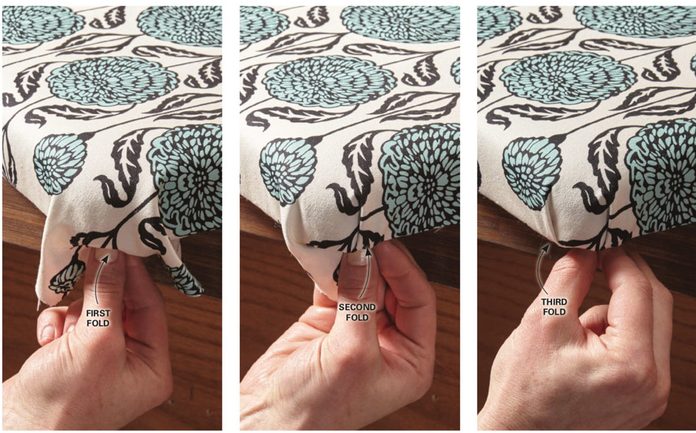
Create a 'butterfly corner' by first tucking the center under, then folding and tucking the material to each side. Flip the seat over and drive staples to hold the corner tight.
Reader Project: Comfortable Adirondack Chair
Step 11
Install the dust cover
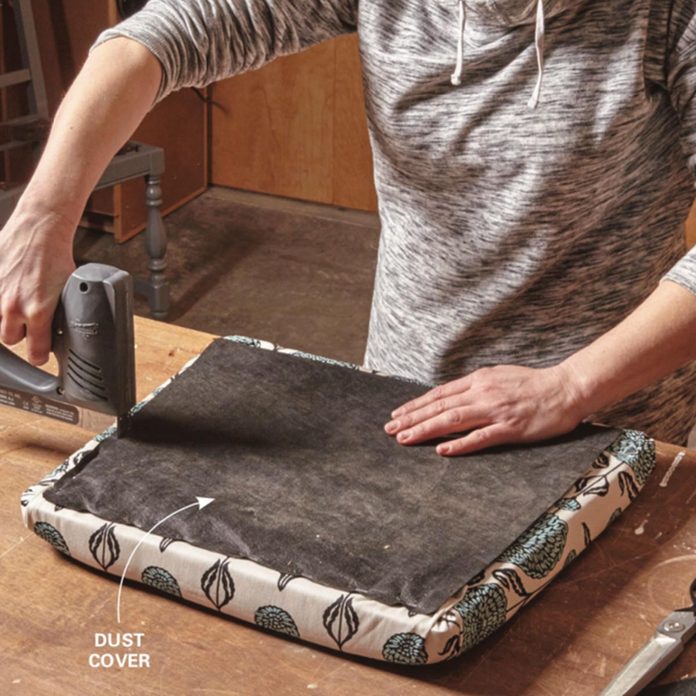
After you trim the excess fabric and batting, staple on a dust cover-we used landscape cloth. A dust cover neatly hides the exposed fabric edges. You can make simple, single-fold 'hospital corners' if the edges of your seat are concealed by a frame. But in most cases, the front corners will be exposed and will look better with a 'butterfly corner.'
Remove excess batting and material from the corners (Photo 7) then flip the seat right side up and experiment with a few corner tucks. Fold the center inward, then overlap each side onto that fold (Photo 8). When the corner looks symmetrical and tight, flip the seat over and staple the folds in place.
When the corners are done, flip the seat over and cut off the excess material. Staple on a dust cover (Photo 9).
Fix a Wobbly Chair: Reglue a Wooden Chair
How To Reupholster A Dining Chair New Foam
Source: https://www.familyhandyman.com/project/how-to-reupholster-a-chair/








Tidak ada komentar:
Posting Komentar